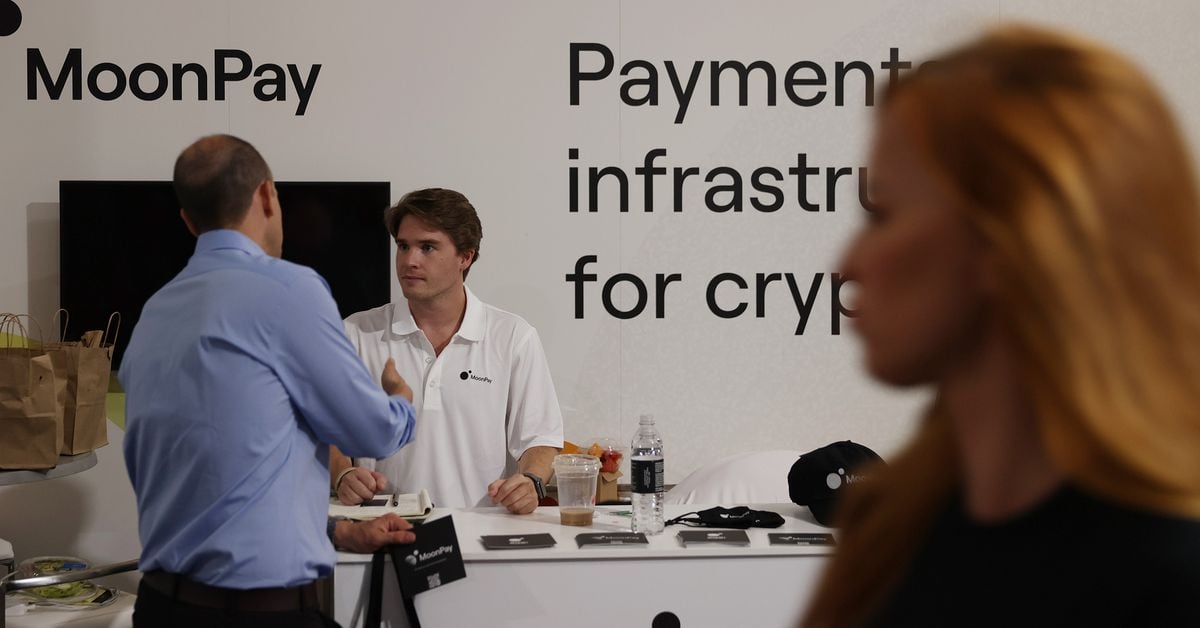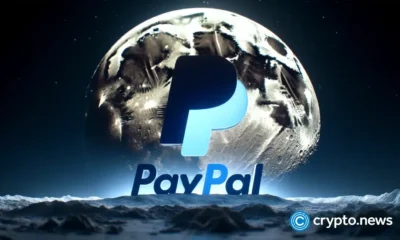News
Why MoonPay and PayPal (PYPL) Partnered to Expand Crypto Adoption in the U.S.

CoinDesk’s Jennifer Sanasie interviewed MoonPay co-founder and CEO Ivan Soto-Wright for CoinDesk TV’s “First Mover” on May 3, to discuss MoonPay’s recent partnership with PayPal. Here is the full transcript of the interview.
Jennifer Sanasie: MoonPay users can now buy crypto via PayPal (PYPL). The new partnership means that users in the US can seamlessly purchase crypto with PayPal through wallet transfers, bank transfers and debit card transactions. Now the cryptocurrency buying app is the first company to do this with PayPal. CEO and co founder Ivan Soto Wright says that the partnership will help the company reach more customers. So how is this going to enable mainstream adoption? We explore that now. Ivan Soto-Wright, welcome to First Mover.
Ivan Soto-Wright: Awesome, thanks for having me.
Jennifer Sanasie: Thanks for being here. Now this partnership was announced this week. Let’s start at the basics, lay a foundation for me. How’s this gonna work?
Ivan Soto-Wright: Yeah, so at MoonPay, we’re trying to onboard the world to crypto. And so for us, we’re constantly looking at new payment methods, new geographies we can expand into. And for us, PayPal was a natural fit. 426 million customers that are inside of PayPal can now use their balances, their debit cards that are saved on the platform, and frictionlessly use PayPal inside of MoonPay to top up their favorite wallet.
Jennifer Sanasie: Now, I gotta ask you, I gotta play the devil’s advocate here and I’m doing it because people ask me this all the time. Does the world wanna be onboarded onto crypto? Talk to me about some of your user stories and the future that you envision.
Ivan Soto-Wright: Yeah, well, I think the future of money is definitely cryptocurrency. I think that eventually we’re going to see a place very similar to what we’ve seen with the Internet. So the Internet really brought down the cost of communication. We’re now using voiceover to intero and a protocol to communicate. The same thing will happen for money instead of, you know, all these legacy infrastructure systems that don’t communicate on the same language. We can now move to a system built on Internet built by blockchain where transaction costs, I think, will eventually tend towards zero. We’re in the early phases of that. It’s kind of like the dial-up days. We’re constantly getting faster. We’re getting speedier. We’re going to reduce those cost of transactions. But our job is really just to lower the barriers to enable people to participate.
Jennifer Sanasie: How many years do you think it’s gonna be until we hit that adoption, until we go from dial-up days to 5G?
Ivan Soto-Wright: I mean, it’s already really impressive some of the innovation that you’ve seen on some of these Ethereum blockchains, these layer two solutions. We’ve already gotten to a place of optimism where transaction costs and gas fees are near zero. And we also have new layer one blockchains that are coming to the market. You know, we don’t take a particular take on one blockchain that’s going to succeed. We have a view that there’s going to be multiple blockchains. And really it’s around what are the use cases and the performance that we see as a result of the technology.
Jennifer Sanasie: So you’re not gonna give me any years, no predictions, no looking into the crystal ball.
Ivan Soto-Wright: I think it’s followed a very similar trend to the internet. I would never have imagined that MoonPay now has 20 million customers on the platform. It’s only been five years since we started the business. I still think we’re early days in terms of the overall cycle. I look at market cap somewhat as a proxy. If we look at the Bitcoin market cap today, gold at 12 trillion, Bitcoin around a trillion, we still have a long way to go in terms of adoption of this asset class.
Jennifer Sanasie: Let’s talk about those 20 million customers. I know that there’s a story on coindesk.com. You spoke to us for the launch of this yesterday and you outlined some challenges that customers had, particularly when they were trying to get fiat onto the platform via things like bank cards. Tell me a little bit more about those issues.
Ivan Soto-Wright: Yeah, unfortunately, you know, it really pains me as the co -founder of the service. One of our biggest complaints that we receive is sometimes people try to use their card and they have that card rejected by their bank. Now we can’t really do much about that. Some banks will decide to decline transactions related to crypto. You know, I think what we see is we want to get to a place where we have the same user experience that we have in traditional fintech. So how do we get there? We partner with traditional fintech and PayPal. Used by over 426 million people. It’s a seamless way that people have used to pay. We’re now forming a partnership with legacy, some of the bigger fintech platforms to enable that same user experience inside this cryptic ecosystem.
Jennifer Sanasie: Have you attempted to form partnerships with any of the banks or have conversations with the banks about this? I know it’s not just a MoonPay problem, it’s a problem for almost every platform that allows people to buy and trade crypto in the United States and Canada where I’m from, but have you had any conversations with the banks?
Ivan Soto-Wright: Yeah, I mean, we’re in constant contact with pretty much everyone in this industry. We’re always thinking on behalf of our users, how do we provide a better experience? Some banks have updated their policies, some banks haven’t. So it just comes down to their appetite. Kind of similar to what you’re seeing in the ETF world. There’s obviously some players that have decided to not participate full stop. There’s others that are really leaning into it like BlackRock. So I think a very similar thing has taken place with banks and their…willingness to work inside this industry. I think for them, the challenge is there are some risks when it comes to cryptocurrency. When you deliver cryptocurrency over a blockchain, it’s final. So there’s no way to reverse that transaction. And so you do have a potential increased risk for fraud. A lot of the work that we do at MoonPay is to really build the best fraud models to determine should we accept or reject this particular customer and try to de -risk that as much as possible. So we try to do our part. Because we do think this technology is the future and we think that over time that appetite will change. We think that more banks will recognize that this is an important industry to be part of and we’ll need tooling like MoonPay.
Jennifer Sanasie: You mentioned 20 million customers. Talk to me about how active they are these days. And the reason I ask you that is because it felt like we were going to have an epic year in crypto in January when the ETFs were approved. And now it’s feeling a little bit weird if we look at some of what’s going on from a macro perspective. The price of Bitcoin is down. There are net outflows with the ETFs now. Talk to me about your user base. Are you seeing an influx of new users? How active are they?
Ivan Soto-Wright: Yeah, we actually saw a 43% increase in activity over the last quarter. So we had our best quarter in our five -year history in Q1 this year. And that’s given the backdrop of very high interest rates. Most people thought that if interest rates were going to persist at these levels, crypto was not going to be a thing. We’ve actually kind of seen the opposite. I think a lot of our work is still just trying to improve the user experience. We really believe that if we get the user experience right, people will start to opt into these products similar to how people start to opt in to zoom and you know All these amazing applications that are built on voice over the internet protocol We think the same thing will take place for money and all these new crypto applications, but we’re looking at a long period of time. So if you look at the general trend, I try not to look at trends within a year or six months. I really look at zooming out, look at the long term. It’s up and to the right. There’s more developers coming into the ecosystem. There’s new applications that are being built. It just takes time for this ecosystem to flourish.
Jennifer Sanasie: You know, I spoke to tech journalist Kara Swisher recently, and I asked her if she thought that we were in a similar phase to the beginning of the internet. You know, she’s been around, she’s reported quite deeply on the beginning of the internet, and she told me no, she thinks that this sector is a sector that will be around, but maybe not as grand as us who work in the industry like to say it is. Would you agree with that sentiment, or what do you think?
Ivan Soto-Wright: I think with any new technology, there’s obviously a lot of hype. You go through a hype cycle where everyone is extremely excited about all the promise and then reality sets in. And when it comes down to the reality, the reality for crypto today is the user experience is not where it needs to be. And so that’s where we’re very committed to our mission of making crypto more like your experience with your fintech than, you know, I think traditional crypto companies that, you know, when I started, there wasn’t even graphical user interfaces for some of these wallets. Like you had to use your terminal. It’s gotten markedly better and I think the experiences will continue to improve.
Jennifer Sanasie: Talk to me a little bit more about that user experience because I think everyone agrees that the user experience needs to get better and we have great web two apps with great user experiences. Where are the challenges? What are the issues facing developers when it comes to creating a good user experience? Because we know what a good user experience looks like. It just feels like we can’t really get it right.
Ivan Soto-Wright: Yeah, well, I think from our side, it’s just constant. We have this word inside of MoonPay called Kaizen, which is continuous improvement. It’s these 1 % incremental improvements that you make every single day. You do that over a year, and that’s a 3 ,000 % improvement. So we’re constantly learning from our users. The reality is it just takes time. You have to adapt that product. You have to get that feedback. You need to listen to your customers. And obviously, trying to solve some of the biggest pain points for them. Like, it’s not acceptable if you have a high decline rate because you’re getting rejected by your bank. We do things like we prompt the customer based on the six digits of the card number. We could tell them, hey, you could try another payment method. Now we can tell them to try PayPal.
Jennifer Sanasie: Talk to me a little bit about the partnership with PayPal. What was that journey like? Was PayPal on board from the get -go? Did it take a little bit of convincing? What was that, I don’t wanna call it the dating phase like?
Ivan Soto-Wright: Well, we’ve always had huge admiration for PayPal. They’re a phenomenal company. They’ve always been an innovator. Even since the early days, I remember using PayPal on eBay. I would sell things in my garage online. That was the first time I received money. It was actually through my PayPal account. I see us as kind of building the next frontier. In the same way that you use PayPal to interact with the world of e -commerce, you can use MoonPay to interact the world of crypto and all these new applications. And so I thought it was a natural partnership. I thought that if we could improve the conversion rates for our customers, it was a no brainer. And so we’ve been spending a lot of time with that team and we’re really impressed. They’ve actually really leaned into crypto. They’ve been proactive in trying to support more assets on their platform. They’ve invested heavily in their stable coin initiative, which I think has huge promise. I think we’re in the early days of stable coins, but really now you can move frictionlessly money across many different geographies, cross border. They just announced a partnership with zoom. I definitely see the use case for stablecoins being quite strong. We’re in the early days. We’re obviously still getting to regulatory clarity in the United States around how these things should be backed. But I think ultimately they’re going to be an important part of our financial system.
Jennifer Sanasie: I know you spoke to a CoinDesk reporter and said it took some time to get PayPal comfortable with the relationship. What did you mean there?
Ivan Soto-Wright: It just took time in terms of any major integration. You just have to go through a process. So it’s obviously not as fast. As CEO, I want everything to happen yesterday. And so it just takes time to get these things done. But eventually, we get them done.
Jennifer Sanasie: Now you are known at MoonPay for the big mainstream partnerships, the big flashy celebrity partnerships. I know late last year there was a MasterCard partnership announced. Any progress there?
Ivan Soto-Wright: Yeah, so the MasterCard partnership is one of our most exciting ones. We actually did something very cool at the Arnold Palmer Golf Invitational very recently, where they’re starting to look at how do they bring priceless experiences to their customers. Priceless has always been their tagline at MasterCard. And so what they did is they did a bunch of really cool activations at the event. If you scanned, you know, there was a bunch of different QR codes and NFC chips inside the actual event. And if you scan them or you interact with these NFC chips, you would gain collectibles. And some of those collectibles offered you tickets. So if you won’t manage to find all these collectibles inside the actual tournament, you would get offered tickets the next day. So it’s thinking, how do we provide better experiences to our customers? It’s not necessarily, oh, I’m getting an asset because I believe it’s going to go up in value. It’s an asset that actually has utility.
Jennifer Sanasie: Any other big partnerships you can let us know about?
Ivan Soto-Wright: We’ll have more very soon, but I think this PayPal one is the one that we’re super concentrated at the moment. We want to make this a roaring success. We want as many of our users to take it up and actually see success with being able to onboard. It’s great for us. Also, for people that have bank payment methods that they’d like to use, they can now use them through PayPal.
Jennifer Sanasie: Now, I gotta ask you, everyone who works in this industry has one sector of it that they’re very excited about, one that they watch very closely, and it’s not always the one that we focus on in our everyday job. Is there a sector in this industry that you’re really excited about if you look beyond MoonPay and what MoonPay is doing?
Ivan Soto-Wright: I still think we’re really early days around the use cases for NFTs. I’m still quite excited about the promise of NFTs. I think we’re still early days in terms of how we think about programming content on the blockchain. And so I think things like tickets make a lot of sense to me. I think the ticketing industry today has a lot of inefficiencies. I think a lot of them could be solved by having a robust system that I think will be built on blockchain. I also think gaming assets, I think inside of games, a lot of people collect these digital assets, but they’re constrained to the environments. They’re in the same way that your money, in a lot of cases, is being held by all these third parties, your data, your property that you have inside of these games is held by third parties, you can now own and control them yourself. And I think that will be the future.
Jennifer Sanasie: You and I are excited about the same things in this industry, so great minds. I’ve been, yeah, of course. Thank you very much for joining me today.
Ivan Soto-Wright: Appreciate that.
Ivan Soto-Wright: Awesome. Thanks, Jen.
News
Cryptocurrency Price August 1: Bitcoin Dips Below $65K; Solana, XRP Down Up To 8%

Major cryptocurrencies fell in Thursday trading following the Federal Reserve’s decision to keep its key interest rate unchanged. Overnight, the U.S. Federal Reserve kept its key interest rate at 5.25-5.5% for the eighth consecutive time, as expected, while also signaling the possibility of a rate cut at its next meeting in September. The unanimous decision by the Federal Open Market Committee reflects a continued wait-and-see approach as it monitors inflation trends.
CoinSwitch Markets Desk said: “Bitcoin has fallen below $65,000 after the US Federal Reserve announced it would keep interest rates unchanged. However, with markets now anticipating rate cuts at the next Federal Reserve meeting in September, the outlook for a Bitcoin rally by the end of the year has strengthened.”
Meanwhile, CoinDCX research team said: “The crypto market has plunged after the Fed decision. Tomorrow’s US unemployment rate announcement is expected to induce more volatility, with the ‘actual’ figure coming in higher than the ‘expected’ one, which is positive for cryptocurrencies.”
At 12:21 pm IST, Bitcoin (BTC) was down 3.2% at $64,285, while Ethereum was down nearly 4.5% at $3,313. Meanwhile, the global market cryptocurrency The market capitalization fell 3.6% to around $2.3 trillion in the last 24 hours.
“Bitcoin needs to clear its 200-day EMA at $64,510 to consolidate further. Otherwise, a retest of $62,000 could be in the cards,” said Vikram Subburaj, CEO of Giottus.
Altcoins and meme coins, such as BNB (3%), Solana (8%), XRP (5.7%), Dogecoin (5%), Cardano (4.6%), Avalanche (4.3%), Shiba Inu (3.8%), Polkadot (3.4%), and Chainlink (4%) also saw declines.
The volume of all stablecoins is now $71.64 billion, which is 92.19% of the total cryptocurrency market volume in 24 hours, according to data available on CoinMarketCap. Bitcoin’s dominance is currently 54.99%. BTC volume in the last 24 hours increased by 23.3% to $35.7 billion.
(Disclaimer: Recommendations, suggestions, opinions and views provided by experts are personal. They do not represent the views of the Economic Times)
(You can now subscribe to our ETMarkets WhatsApp Channel)
News
Altcoins WIF, BONK, RUNE, JUP Down 10% While Bitcoin Drops 4%

Altcoins dogwifhat, Bonk, THORChain, and Jupiter have suffered losses of more than 10%, while Bitcoin is down 4% in the last 24 hours.
After a period of relative calm yesterday, July 31, Bitcoin (BTC) price action has seen a drastic change as the cryptocurrency dropped by more than $3,500, bringing its value to $63,300. At the same time, altcoins mirrored this trend, with the total value of liquidated positions rising to nearly $225 million over the course of the day.
Initially, the week started on a positive note for Bitcoin, which reached its highest point since early June, hitting $70,000. However, this peak was short-lived, as it was quickly rejected, leading to a substantial decline, with Bitcoin falling below $65,500.
The cryptocurrency managed to regain some stability, trading comfortably at around $66,800. However, following a Press conference According to Federal Reserve Chairman Jerome Powell, the value of Bitcoin has fallen again to $64,300, down more than 3% in 24 hours.
BTC Price Chart 24 Hours | Source: crypto.news
The recession coincided with a relationship from the New York Times stating that Iran had called for retaliatory measures against Israel following the assassination of Hamas leader Ismail Haniyeh in Tehran, increasing the risk of further conflict in the region.
Meanwhile, on the economic front, the Federal Reserve decided to keep its benchmark interest rates in place, offering little information on a planned September rate cut. Powell also hinted that while no concrete decisions have been made on the September adjustment, there is growing consensus that a rate cut is likely.
Amid Bitcoin’s decline, altcoins have suffered even more significant losses. For example, dogwifhat (Wife) saw a 12.4% drop and (DISGUST) has suffered a 10% drop. Other altcoins such as THORChain (RUNE) also fell by 10%, while Jupiter (JUPITER) and the Ethereum naming service (ENS) decreased by 8% and 9% respectively.
Among the largest-cap cryptocurrencies, the biggest losers are Solana (SOL) with a decrease of 8%, (Exchange rate risk) down 6%, Cardano (ADA) down 4%, and both Ethereum (ETH) and Dogecoin (DOGE) recording a decrease of 4.4%.
Data from CoinGlass indicates that approximately 67,000 traders have been negatively impacted by this increased volatility. BTC positions have seen $61.85 million in liquidations, while ETH positions have faced $61 million. In total, the value of liquidated positions stands at $225.4 million at the time of writing.
News
Riot Platforms Sees 52% Drop in Bitcoin Production in Q2

Bitcoin mining firm Riot Platforms has released its second-quarter financial results, highlighting a decline in cryptocurrency mined due to the recent halving.
Colorado-based Bitcoin (BTC) mining company Riot platforms revealed its second quarter financial results, highlighting a significant reduction in mined cryptocurrencies attributed to the recent halving event that took place in early April.
The company reported total revenue of $70 million for the quarter ended July 31, a decline of 8.7% compared to the same period in 2023. Riot Platforms attributed the revenue decline primarily to a $9.7 million decrease in engineering revenue, which was partially mitigated by a $6 million increase in Bitcoin extraction income.
During the quarter, the company mined 844 BTC, representing a decline of over 50% from Q2 2023, citing the halving event and increasing network difficulty as major factors behind the decline. Riot Platforms reported a net loss of $84.4 million, or $0.32 per share, missing Zacks Research forecast a loss of $0.16 per share.
Halving increases competitive pressure
The Colorado-based firm said the average cost of mining one BTC in the second quarter, including energy credits, rose to $25,327, a remarkable 341% increase from $5,734 per BTC in the same quarter of 2023. Despite this significant increase in production costs, the firm remains optimistic about maintaining competitiveness through recent deals.
For example, following the Recent acquisition Cryptocurrency firm Block Mining, Riot has increased its distributed hash rate forecast from 31 EH/s to 36 EH/s by the end of 2024, while also increasing its 2025 forecast from 40 EH/s to 56 EH/s.
Riot Platforms Hashrate Growth Projections by 2027 | Source: Riot Platforms
Commenting on the company’s financials, Riot CEO Jason Les said that despite the halving, the mining company still managed to achieve “significant operational growth and execution of our long-term strategy.”
“Despite this reduction in production available to all Bitcoin miners, Riot reported $70 million in revenue for the quarter and maintained strong gross margins in our core Bitcoin mining business.”
Jason Les
Following its Q2 financial report, Riot Platforms shares fell 1.74% to $10.19, according to Google Finance data. Meanwhile, the American miner continues to chase Canadian rival Bitfarms, recently acquiring an additional 10.2 million BITF shares, increasing its stake in Bitfarms to 15.9%.
As previously reported by crypto.news, Riot was the first announced a $950 million takeover bid for Bitfarms in late May, arguing that Bitfarms’ founders were not acting in the best interests of all shareholders. They said their proposal was rejected by Bitfarms’ board without substantive engagement.
In response, Bitfarms She said that Riot’s offer “significantly understates” its growth prospects. Bitfarms subsequently implemented a shareholder rights plan, also known as a “poison pill,” to protect its strategic review process from hostile takeover attempts.
News
Aave Price Increases Following Whales Accumulation and V3.1 Launch

Decentralized finance protocol Aave is seeing a significant spike in whale activity as the market looks to recover from the recent crash that pushed most altcoins into key support areas earlier this week.
July 31, Lookonchain shared details indicating that the whales had aggressively accumulated Aave (AAVE) over the past two days. According to the data, whales have withdrawn over 58,848 AAVE worth $6.47 million from exchanges during this period.
In one instance, whale address 0x9af4 withdrew 11,185 AAVE worth $1.23 million from Binance. Meanwhile, another address moved 21,619 AAVE worth over $2.38 million from the exchange and deposited the tokens into Aave.
These withdrawals follow a previous transfer of 26,044 AAVE from whale address 0xd7c5, amounting to over $2.83 million withdrawn from Binance.
AAVE price has surged over 7% in the past 24 hours amid buy-side pressure from these whales. The DeFi token is currently trading around $111 after jumping over 18% in the past week.
Recently, the price of AAVE increased by over 8% after Aave founder Marc Zeller announced a proposed fee change aimed at adopting a buyback program for AAVE tokens.
Aave v3.1 is available
The total value locked in the Aave protocol currently stands at around $22 billion. According to DeFiLlamaApproximately $19.9 billion is on Aave V3, while the V2 chain still holds approximately $1.9 billion in TVL and V1 approximately $14.6 million.
Aave Labs announced Previously, Aave V3.1 was made available on all networks with active Aave V3 instances.
V3.1 features improvements that are intended to improve the overall security of the DeFi protocol. The Aave DAO governance has approved the v3.1 improvements, which also include operational efficiency and usability for the network.
Meanwhile, Aave Labs recently outlined a ambitious roadmap for the projectwith a 2030 vision for Aave V4, among other developments.
-

 Regulation7 months ago
Regulation7 months agoRipple CTO and Cardano founder clash over XRP’s regulatory challenges ⋆ ZyCrypto
-

 Regulation5 months ago
Regulation5 months agoNancy Pelosi Considers Supporting Republican Crypto Bill FIT21 – London Business News
-

 Videos6 months ago
Videos6 months agoCryptocurrency News: Bitcoin, ETH ETF, AI Crypto Rally, AKT, TON & MORE!!
-

 Regulation6 months ago
Regulation6 months agoBitcoin’s future is ‘bleak’ and ripe for regulation, says lead developer
-

 News6 months ago
News6 months agoThe trader earned $46 million with PEPE after reaching a new ATH
-

 Blockchain6 months ago
Blockchain6 months agoSolana ranks the fastest blockchain in the world, surpassing Ethereum, Polygon ⋆ ZyCrypto
-

 Blockchain6 months ago
Blockchain6 months agoSolana Surpasses Ethereum and Polygon as the Fastest Blockchain ⋆ ZyCrypto
-

 Regulation6 months ago
Regulation6 months ago🔒 Crypto needs regulation to thrive: Tyler Cowen
-

 Videos6 months ago
Videos6 months agoWho Really CONTROLS THE MARKETS!! Her plans REVEALED!!
-

 Videos7 months ago
Videos7 months agoKucoin safe?? Exchange REVIEW and beginner’s guide!!
-

 Blockchain6 months ago
Blockchain6 months ago“Liquid vesting” is an oxymoronic feature of blockchain that allows early investors to sell without waiting
-

 Videos6 months ago
Videos6 months agoInstitutions purchasing MEMECOINS?! Everything you need to know!

















